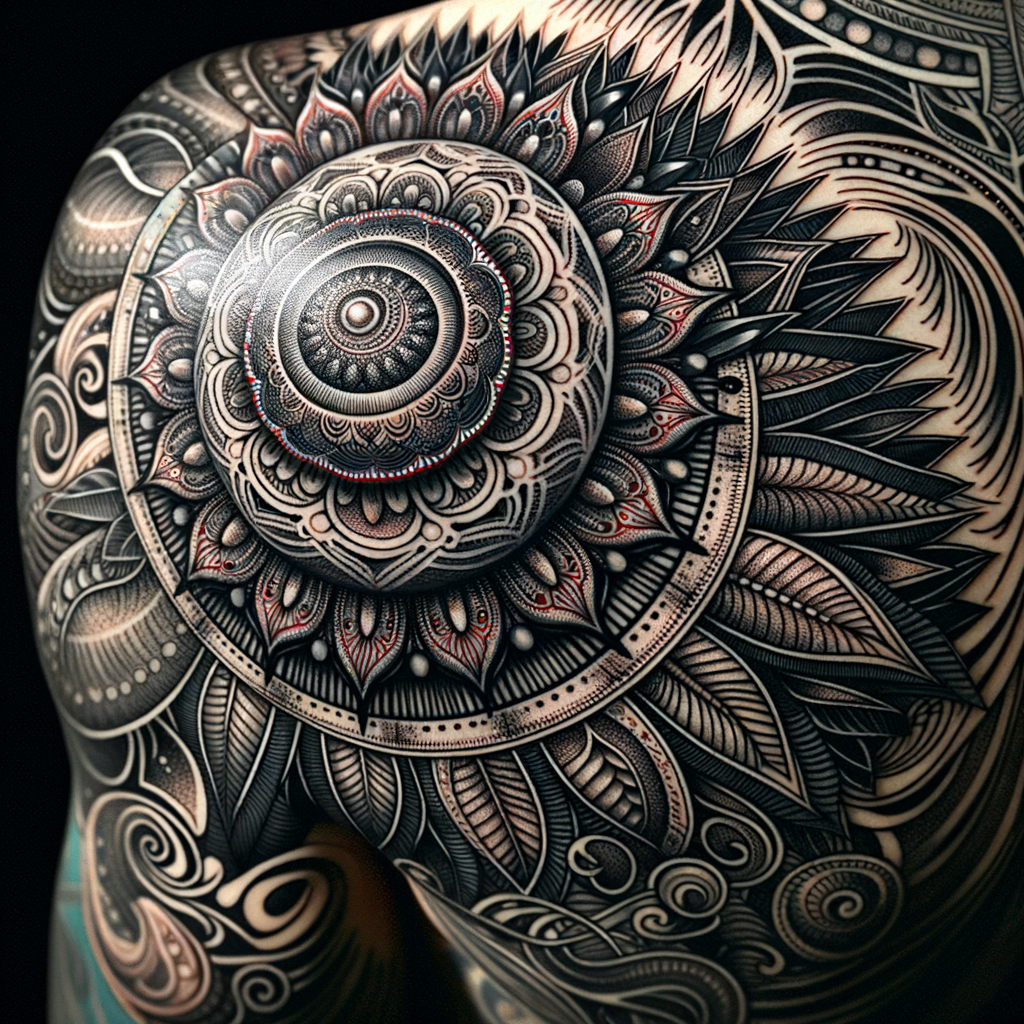
Introduction to Line Work Tattoo Art
Line work is a fundamental aspect of tattoo artistry. It involves the use of lines to create shapes, patterns, and images on the skin. This introductory section will help you understand the basics of line work in tattooing and the importance of detailed tattoo art in modern tattoo artistry.
- Understanding the basics of Line Work in Tattooing
- Importance of Detailed Tattoo Art in modern Tattoo Artistry
Line work is the backbone of any tattoo design. It involves the use of lines to create shapes and images on the skin. The lines can be thick or thin, straight or curved, and can be used to create a variety of effects. For example, a tattoo artist might use thin lines to create delicate details, or thick lines to create bold, striking images. The quality of line work can greatly affect the overall look and feel of a tattoo. Poor line work can make a tattoo look messy and unprofessional, while good line work can make a tattoo look clean, crisp, and professional.
In modern tattoo artistry, detailed tattoo art is highly valued. This is because detailed tattoos can express more complex ideas and emotions than simpler designs. They can also be more visually appealing, attracting more attention and admiration. In fact, many of today’s most popular tattoo styles, such as realism and neo-traditional, rely heavily on detailed line work. These styles use intricate lines and details to create realistic images and bold, colorful designs. Therefore, mastering detailed line work is a crucial skill for any aspiring tattoo artist.
In conclusion, line work is a fundamental aspect of tattoo artistry. It involves the use of lines to create shapes, patterns, and images on the skin. The quality of line work can greatly affect the overall look and feel of a tattoo, and detailed line work is highly valued in modern tattoo artistry. Therefore, understanding the basics of line work and the importance of detailed tattoo art is crucial for anyone interested in tattoo artistry.
Exploring Fine Detailing in Tattoos
In the world of tattoo art, fine detailing is a skill that separates the masters from the novices. This section will delve into the techniques used to achieve intricate designs and the precision required to create them.
Techniques for Fine Line Tattoo Art
There are two essential techniques that artists use to create fine line tattoo art: studying the use of thin needles and mastering the art of precision and steadiness.
- Studying the use of thin needles
- Mastering the art of precision and steadiness
Thin needles are the secret weapon of any fine line tattoo artist. They allow for the creation of detailed and delicate designs that would be impossible with thicker needles. The use of thin needles requires a deep understanding of their capabilities and limitations. For instance, they can create intricate patterns but are also more prone to causing skin damage if not handled correctly.
Creating fine line tattoos requires a steady hand and a keen eye for detail. Artists must be able to maintain a consistent pressure and angle throughout the tattooing process to ensure the lines are uniform and the design is executed accurately. This level of precision and steadiness is often achieved through years of practice and experience.
In conclusion, mastering the techniques of fine line tattoo art is a journey that requires dedication, practice, and a deep understanding of the tools and techniques involved. It’s a journey that leads to the creation of stunning, intricate designs that are a testament to the skill and artistry of the tattoo artist.
Examples of Intricate Tattoo Designs
When it comes to intricate tattoo designs, there are countless examples from around the world. However, two styles that truly stand out for their complexity and detail are Japanese Irezumi and Polynesian tribal tattoos. Let’s take a closer look at these fascinating art forms.
-
Case study: Japanese Irezumi
Japanese Irezumi, or traditional Japanese tattoos, are known for their intricate designs and deep cultural significance. These tattoos often cover large areas of the body and feature a variety of themes, from mythical creatures like dragons and phoenixes to natural elements like flowers and waves.
One of the most distinctive features of Irezumi is its use of bold, black outlines and vibrant colors. The level of detail in these designs is truly remarkable, with each element carefully crafted to tell a story or convey a specific meaning.
Despite the complexity of these designs, Irezumi artists are able to achieve incredible precision and clarity, making each tattoo a unique work of art.
-
Case study: Polynesian Tribal Tattoos
Polynesian tribal tattoos, also known as Tatau, are another example of intricate tattoo designs. These tattoos are deeply rooted in Polynesian culture and tradition, with each design telling a story about the wearer’s identity, status, or personal achievements.
Polynesian tribal tattoos are characterized by their geometric patterns and symmetrical designs. Despite their seemingly simple shapes, these tattoos require a high level of precision and skill to execute, as each line and curve must be perfectly aligned and evenly spaced.
Like Irezumi, Polynesian tribal tattoos are a testament to the artistry and craftsmanship of tattoo artists, showcasing their ability to create intricate designs that are both visually stunning and deeply meaningful.
Line Work in Tattooing: A Deeper Dive
As we delve deeper into the world of tattoo artistry, it becomes clear that line work plays a pivotal role in creating a masterpiece on skin. It’s not just about drawing lines; it’s about understanding their purpose and how they contribute to the overall design.
Understanding the Role of Line Work in Tattoo Artistry
Line work in tattooing is more than just drawing on the skin. It’s about creating a framework for the design and adding depth and dimension to it. Let’s explore how line work contributes to these aspects.
- Defining the shape and form
- Creating depth and dimension
Line work is the backbone of any tattoo design. It outlines the shape and form of the design, giving it structure and definition. Without line work, a tattoo would lack clarity and precision. It’s like the blueprint of a building; it outlines the structure, giving the artist a clear path to follow.
Line work also plays a crucial role in creating depth and dimension in a tattoo. By varying the thickness and spacing of lines, an artist can create the illusion of depth, making a flat image appear three-dimensional. This is especially important in realistic tattoos where depth and perspective are key to achieving a lifelike result.
In conclusion, line work in tattooing is not just about drawing lines; it’s about using those lines to define shapes, create depth, and bring a design to life. It’s a skill that requires practice, precision, and a deep understanding of art principles.
Challenges in Tattoo Detailing Techniques
As we delve deeper into the world of tattoo artistry, it’s important to acknowledge the hurdles that artists often face. Two of the most common challenges include managing client expectations and overcoming technical difficulties. Let’s take a closer look at these obstacles.
- Managing Client Expectations
One of the most challenging aspects of tattoo detailing is managing the expectations of clients. Clients often come in with high hopes and specific ideas for their tattoos. They may have seen a design online or in a magazine and want an exact replica. However, it’s important to remember that every person’s skin is different, and what works on one person may not work on another.
As a tattoo artist, it’s crucial to communicate this to clients. It’s also important to help them understand the limitations of tattoo detailing. For instance, intricate designs may not look as sharp on skin as they do on paper. This is due to the natural texture and color of the skin. By managing client expectations, tattoo artists can ensure a more satisfying experience for their clients.
- Overcoming Technical Difficulties
Another challenge in tattoo detailing is overcoming technical difficulties. Tattooing is a complex art form that requires a steady hand and a deep understanding of the tools and techniques involved. The smallest error can result in a permanent mistake.
For example, the thickness of the needle can greatly affect the outcome of a tattoo. A thicker needle can create bold lines, but it may not be suitable for fine detailing. On the other hand, a thinner needle can create delicate lines, but it may not be strong enough to penetrate the skin deeply. Therefore, choosing the right needle is a critical skill for any tattoo artist.
Furthermore, the speed and pressure applied during the tattooing process can also impact the final result. Too much pressure can cause the ink to spread, blurring the lines. On the contrary, too little pressure may result in faint lines that fade over time. Hence, mastering the balance between speed and pressure is another technical difficulty that tattoo artists must overcome.
In conclusion, while tattoo detailing can be challenging, with patience, practice, and clear communication, these obstacles can be overcome. Remember, the beauty of tattoo artistry lies not only in the final product but also in the journey of creating it.
Mastering Intricacy in Tattoo Design
Creating intricate tattoo designs requires a deep understanding of various techniques and principles. This section will explore some of the advanced techniques that can help you achieve detailed and captivating tattoo art.
Advanced Techniques for Detailed Tattoo Art
Two key techniques that can significantly enhance the intricacy of your tattoo designs are the use of gradients and shading, and the implementation of color theory. Let’s delve into each of these techniques.
- Using gradients and shading
- Implementing color theory
Gradients and shading are essential tools in creating depth and dimension in your tattoo designs. They can transform a flat image into a lifelike representation. Gradients involve a smooth transition from one color to another, often used to create a light-to-dark effect. Shading, on the other hand, involves adding black or grey tones to a design to give it depth and volume. For example, a rose tattoo can go from simple to stunning with the right use of gradients and shading, making the petals appear more realistic.
Color theory is another crucial aspect of intricate tattoo design. Understanding how different colors interact and influence each other can help you create designs that are visually harmonious. For instance, knowing that red and green are complementary colors can help you design a tattoo where these colors enhance each other’s vibrancy. Similarly, understanding the emotional connotations of different colors can help you create tattoos that resonate with your clients on a deeper level. For example, blue is often associated with calmness and stability, while red can symbolize passion and energy.
Mastering these techniques will not only enhance your tattoo designs but also elevate your artistry to new heights. Remember, practice is key in honing these skills. So, keep experimenting and learning to become a master in intricate tattoo design.
Key Takeaways for Aspiring Tattoo Artists
As an aspiring tattoo artist, there are a few key points that you should always keep in mind. These will not only help you to improve your skills but also ensure that you stay relevant in this dynamic field.
- Importance of Continuous Learning
- Staying Updated with Latest Trends
Continuous learning is crucial in the field of tattoo artistry. The art of tattooing is constantly evolving, with new techniques, styles, and tools being introduced regularly. To stay at the top of your game, it’s important to keep learning and improving. This could involve attending workshops, enrolling in online courses, or even learning from fellow artists. Remember, the more you learn, the better you become.
Just like in fashion, trends in tattooing change frequently. What’s popular today might not be tomorrow. Therefore, it’s essential to stay updated with the latest trends. This doesn’t mean you have to follow every trend, but being aware of them can help you to better cater to your clients’ needs and preferences. You can stay updated by following popular tattoo artists on social media, subscribing to tattoo magazines, or attending tattoo conventions.
In conclusion, continuous learning and staying updated with the latest trends are key to becoming a successful tattoo artist. Remember, the journey to becoming a great tattoo artist is a marathon, not a sprint. So, take your time, keep learning, and always strive to improve.
Conclusion: The Artistry of Tattoo Line Work
As we conclude our exploration of the artistry of tattoo line work, it’s clear that this form of expression is much more than skin deep. It’s a testament to the skill and creativity of the tattoo artist, and a reflection of the individuality of the person wearing the tattoo. Let’s take a moment to appreciate the complexity of fine line tattoo art and consider the future trends in intricate tattoo designs.
- Appreciating the complexity of Fine Line Tattoo Art
- Future trends in Intricate Tattoo Designs
Fine line tattoo art is a testament to the precision and skill of the tattoo artist. It involves creating intricate designs with thin, precise lines, often without the use of color. This style of tattooing requires a steady hand and a keen eye for detail. Each line must be perfectly placed to create a cohesive and visually stunning design. The complexity of this art form is truly awe-inspiring, and it’s a testament to the talent and dedication of the artists who master it.
As we look to the future, it’s clear that the world of tattoo design is constantly evolving. Artists are continually pushing the boundaries of what’s possible, experimenting with new techniques and styles. One trend we’re seeing is a move towards even more intricate designs, with artists creating incredibly detailed tattoos that are almost photorealistic. Another trend is the use of color to add depth and dimension to fine line tattoos. As technology continues to advance, we can expect to see even more innovation in the world of tattoo design.
In conclusion, the artistry of tattoo line work is a fascinating and complex field. It’s a form of expression that combines skill, creativity, and personal expression in a truly unique way. Whether you’re a tattoo enthusiast or simply an admirer of art, there’s no denying the beauty and intricacy of fine line tattoo art.






